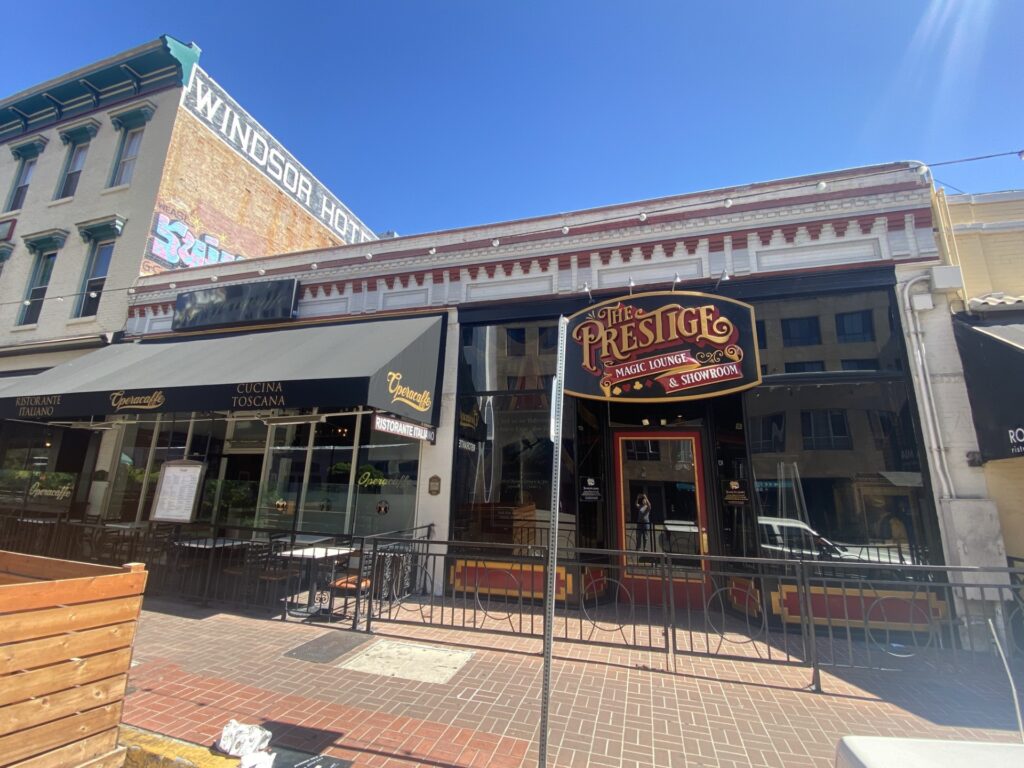No products in the cart.
Landmarks
Successful and Stable
Scott – Ingersoll Building
1905-1907
827-835 Fourth Avenue
Architect: Quayle Brothers
Architectural Style: Commercial
Like all properties in downtown San Diego, Lot D, Block 62 of Alonzo Horton’s original map of the area, started its commercial history with the sale of the property by Horton. In September of 1868, Capt. Samuel Dunnells purchased the entire block for $500. He promptly sold half of the block, which encompassed Lots D, E, F, G, H and I for $350, to William S. Gregg. Gregg and his wife built a dwelling place on the south part of the block, and remained in control of the property until December 1878. It was then that Gregg sold the property to Charles P. Gerichten for $1,000. Gerichten was a well known businessman in early San Diego. Upon his death, the property to the north side passed to his wife, Florentine, his daughter, Ella, who became Mrs. Ernest D. Scott, and his daughter, Kate, who became Mrs. Charles Rensch of Germany. The southern side of the lot passed solely to Ella. The Scotts maintained ownership of their side of the property until 1905, when they sold it to Albert M. Ingersoll for $4,000. Mr. Ingersoll, a longtime San Diego resident, was the owner of “Ingersoll’s Palace of Sweets” located on 5th Avenue. He was also a noted ornithologist, and owned a world-renowned collection of birds’ eggs, which he ultimately donated to the San Diego Museum of Natural History. A man of many interests!
Mr. Ingersoll immediately started construction of a one-story building with provisions in place for additional stories. Completion was slated for September 1, 1905. The building was a rather simple rectangular brick structure with plate glass, commercial-style windows, wainscoted in clear pine. The interior consisted of a large room with a 16 -foot vaulted ceiling, The ceiling and walls were finished in very fine sand colored plaster. Plain utility fixtures completed the room.
One of the first tenants of the building was the Coffee Club Association of San Diego. The purpose of the organization, as listed in the Classified Directory, was to “establish houses of refreshments, recreation and amusement, where no intoxicating liquors, cigars, or tobacco in any form shall be sold.” Could this be the forerunner of Starbuck’s? Probably not, as coffee, pie, soup or doughnuts were only a nickel apiece! It might have been referred to as a poor man’s cafe, but it was also the favorite stop for Alonzo Horton when he needed a pick-me-up. He would unobtrusively walk in, perch on a stool and order pie and milk. And of course, since he was Father Horton, it was always on the house! At other times, he might stroll over to Mr. Ingersoll’s ice cream parlor for a scoop of ice cream or a sarsaparilla – also on the house! The Coffee Club flourished at this address for four years before moving to another downtown location on Fifth Avenue.
By November of 1906, Mr. Ingersoll purchased the north half of the property from Kate, and was now in sole possession of the entire parcel. He im-mediately added a single-story brick structure adjoining and complementing the building on the south side. The following year, the Classified Directory lists Claude Smith and Arthur Walker as maintaining a bicycle shop at the now 835 address. They operated at this address for 22 years, as they expanded the business to include additional sporting goods. While in business there, the partners enhanced the property by adding awnings over the plate glass windows and benches for customers who were waiting. In 1941, the building became the photographic studio of John Gavett.
Following Gavett’s, was Caruso’s Italian Restaurant, which served pasta, sandwiches and pizza from 1952 into the 1990s. This was a favorite place for Saturday night club hoppers, who came to Caruso’s , because it not only served great pizza, but it was the only place still open and serving at 2 am, when the bars closed! The ambience, featuring exposed red brick walls, was also a plus as it featured historic photographs and memorabilia.
The south side of Ingersoll’s property, although primarily a restaurant, did house several other enterprises. The Johnson Cigar Company maintained a business for two years towards the back of the property, and a shoe shop did likewise. After the exit of the Coffee Club Association, the proprietorship of the restaurant facilities changed often. Ultimately, in 1917, it became Crane’s Panama Lunchroom. The new proprietor, Mr. William A. Crane, a transplant from Springdale, Ohio, also owned the Manhattan restaurant, the Mercantile restaurant , and additionally, the Crane Hotel, the Cecil Hotel and the Carnegie Apartments. You may remember the Manhattan Restau-rant as it was on the ground floor, below the Manhattan Hotel, a noted house of ill repute. Below the restaurant, in the basement , a speakeasy operated during Prohibition. The restaurant, though, was quite elegant.
In 1924, the Panama changed proprietorship again, but it remained basically the same operation for the next two decades. It was continually managed during this period by Chris Melista Angius and Nick Gregovich. They sold the business in 1943, but during their stay, the business became known as the Panama Cafe. In 1954, it became the Panama Cafe Tavern. It was followed by a billiard room, the Other Pocket.
The 835 south side has been occupied by the Operacaffe, a cozy Italian restaurant featuring Tuscan food. since 2008. The north side, the 827 ad-dress, is currently occupied by The Prestige – Magic Lounge and Show-room. Throughout the years, both sides have been continually occupied and serving the community.
Sandee is the Historian and Lead Tour Guide for the Gaslamp Quarter Historical Foundation. She can be reached at [email protected].

